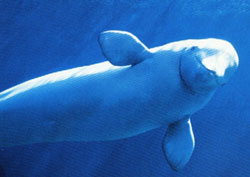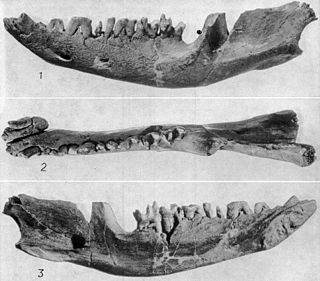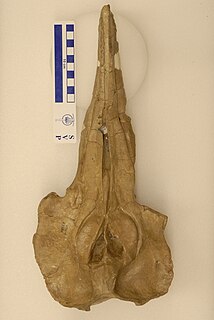
The cetacean family Monodontidae comprises two living whale species, the narwhal and the beluga whale and at least four extinct species, known from the fossil record. Beluga and Narwhal are native to coastal regions and pack ice around the Arctic Ocean. Both species are medium-sized whales, between three and five metres in length, with a forehead melon, and a short or absent snout. They do not have a true dorsal fin, but do have a narrow ridge running along the back, which is much more pronounced in the narwhal. They are highly vocal animals, communicating with a wide range of sounds. Like other whales, they also use echolocation to navigate. Belugas can be found in the far north of the Atlantic and Pacific Oceans; the distribution of narwhals is restricted to the Arctic and Atlantic Oceans.

Eodelphis, from eo- plus [Di]delphis, thus meaning "very early opossum", is a genus of stagodont metatherians from the Late Cretaceous of North America, with distinctive crushing dentition. Named species include E. browni and the more advanced E. cutleri. Both come from the Late Campanian of Dinosaur Provincial Park, Alberta. Specimens are also known from the Judith River Formation of Montana. E. cutleri is related to the Maastrichtian genus Didelphodon as indicated by its enlarged premolars and more robust jaw. Eodelphis was probably an aquatic predator like its relative Didelphodon, and may have weighed about 0.6 kg (1.3 lb), making it one of the largest mammals of its time.

Odobenocetops is an extinct genus of small toothed whale known from Peru and Chile. Its fossils are found in Neogene-aged marine strata dating from the Tortonian to the Zanclean. It had two tusks, and, in some fossils, one tusk was longer than the other.
Kentriodon is an extinct genus of toothed whale related to modern-day dolphins. Fossils have been found in Europe, Japan, Korea, and the Western Hemisphere. Seven species have been described so far.

Sagmatias is a genus of cetacean that contains four dolphin species formerly placed in the genus Lagenorhynchus. Mitochondrial DNA studies have indicated that certain dolphin species within Lagenorhynchus are actually more closely related to dolphins within the genus Cephalorhynchus. In order to resolve this situation it has been proposed that the affected dolphin species be placed within the genus Sagmatias. A recent cladistic analysis of oceanic dolphins provides morphological support for generic separation of Sagmatias from Lagenorhynchus. Affected species are:

Australodelphis mirus is an extinct Pliocene dolphin. A. mirus is known from fossils found in the Sørsdal Formation, Mule Peninsula, Vestfold Hills, East Antarctica. The genus has been described as an example of convergent evolution with beaked whales.

Kentriodontidae is an extinct family of odontocete whales related to modern dolphins. The Kentriodontidae lived from the Oligocene to the Pliocene before going extinct.
Meherrinia is an extinct genus of inioid river dolphin from the Meherrin River, North Carolina, in the United States. First described in 2012, the dolphin is, in most respects, intermediate in form between the living Amazon river dolphin and the La Plata dolphin, although it is probably more closely related to the former. However, the fossil was discovered in what are believed to be marine deposits, dating from the late Miocene, whereas the Amazon river dolphin is an exclusively freshwater species. Meherrinia therefore may be, as of 2012, the only known marine genus of the family Iniidae. Only one species is known.
This article records new taxa of fossil mammals of every kind that have been described during the year 2014, as well as other significant discoveries and events related to paleontology of mammals that occurred in the year 2014.

Otekaikea is an extinct genus of toothed whale closely related to Waipatia. It is known from the late Oligocene (Chattian) of New Zealand.

The Pisco Formation is a geologic formation located in Peru, on the southern coastal desert of Ica and Arequipa. The approximately 640 metres (2,100 ft) thick formation was deposited in the Pisco Basin, spanning an age from the Middle Miocene up to the Early Pleistocene, roughly from 15 to 2 Ma. The tuffaceous sandstones, diatomaceous siltstones, conglomerates and dolomites were deposited in a lagoonal to near-shore environment, in bays similar to other Pacific South American formations as the Bahía Inglesa and Coquimbo Formations of Chile.
Allodelphinidae is a family of primitive platanistoid river dolphins found in marine deposits in the eastern North Pacific region, Alaska, and Japan.
Macrokentriodon is an extinct genus of giant dolphin once assigned to the paraphyletic/polyphyletic family Kentriodontidae. Remains have been found in the late Miocene (Serravallian) Choptank Formation of United States.

Lophocetus is an extinct genus of dolphin belonging to the clade Delphinida that is known from late Miocene (Tortonian) marine deposits in California and Maryland. Although usually placed in Kentriodontidae, recent studies have found it only distantly related to Kentriodon.
Hadrodelphis is an extinct genus of dolphin once assigned to the paraphyletic/polyphyletic family Kentriodontidae. Remains have been found in the middle Miocene (Langhian) Calvert Formation of United States.
Pomatodelphis is an extinct genus of river dolphin from Middle Miocene marine deposits in Alabama, Florida, Brazil, Germany and France.
Archaeophocaena teshioensis is a species of extinct porpoise from the Late Miocene Koetoi Formation of Japan living around 6.4–5.5 million years ago (mya). The holotype specimen comprises a partial skull. The animal, along with Miophocaena and Pterophocaena, seem to represent an intermediary phase between porpoises and dolphins. The genus name derives from Ancient Greek archaeo, "ancient," and Latin phocaena, "porpoise"; the species name honors the Teshio District where the holotype was discovered.
Miophocaena nishinoi is an extinct species of porpoise from the Late Miocene Koetoi Formation of Japan, dating to around 6.4–5.5 million years ago (mya), represented by a partial skull. the genus name derives from Ancient Greek mio for the Miocene, and phocaena for "porpoise"; the species name honors the discoverer, Takanobu Nishino. Miophocaena resides in a clade with Archaeophocaena discovered in the same area, and, along with Pterophocaena, represents an intermediate phase between porpoises and dolphins.
Pterophocaena nishinoi is an extinct species of porpoise discovered in the Late Miocene Wakkanai Formation of Japan dating to 9.3–9.2 million years ago (mya), and may represent an intermediate phase between porpoises and dolphins. It is one of the oldest species discovered, after the Middle Miocene Loxolithax 16–14.8 mya and the Late Miocene Salumiphocaena 12.6–9 mya. The holotype specimen comprises a partial skeleton. The genus name derives from Ancient Greek pteryx, "wing," in reference to its unusually pronounced beak, and Latin phocaena, "porpoise." The species name honors the discoverer of the holotype, Takanobu Nishino.











